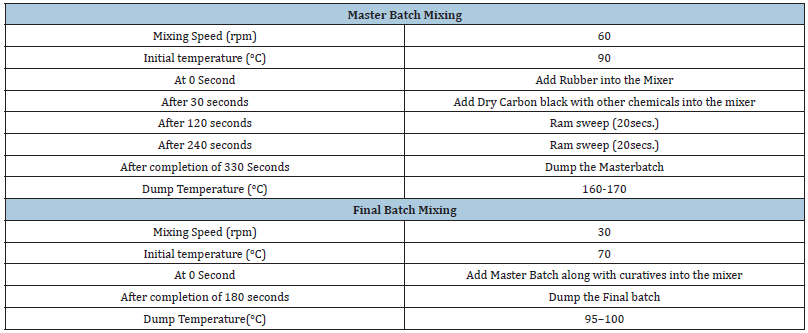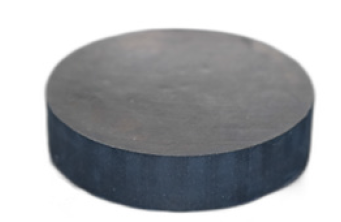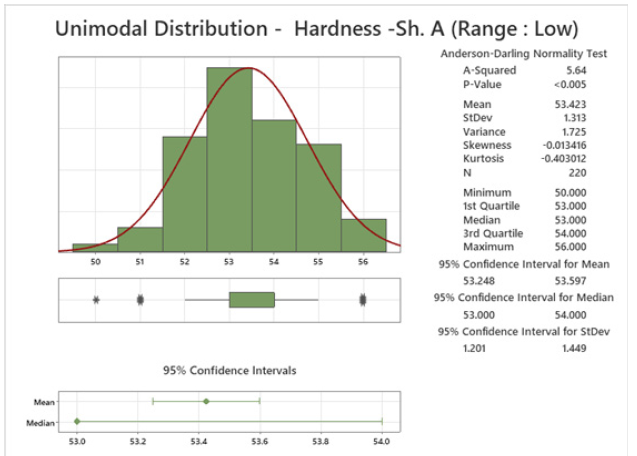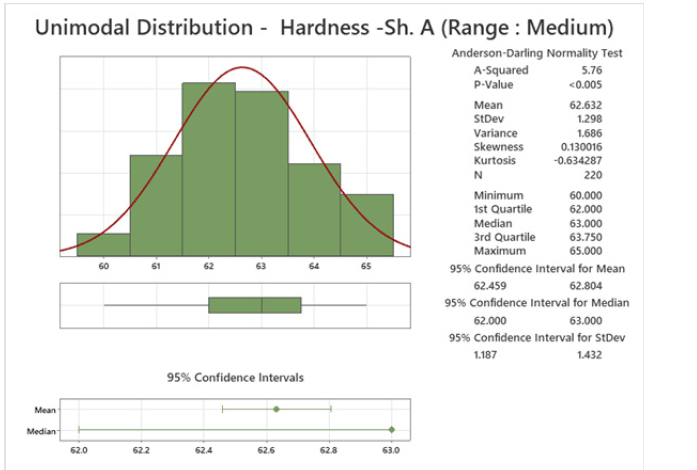- Submissions

Full Text
Polymer Science: Peer Review Journal
Proficiency Testing on Shore A Hardness of Rubber Vulcanizates - A Critical Evaluation
Ajay C*, Saikat Das Gupta, Barun Kumar Samui and Rabindra Mukhopadhyay
Hari Shankar Singhania Elastomer and Tyre Research Institute (Hasetri), India
*Corresponding author: Ajay C, Hari Shankar Singhania Elastomer and Tyre Research Institute (Hasetri), Mysuru-570016, India
Submission: August 05, 2022;Published: September 29, 2022

ISSN: 2770-6613 Volume4 Issue2
Abstract
Proficiency Testing (PT) is one of the means for laboratories to gauge the test data better and subsequently elevates the quality of the result, equipment, and personnel, thus boosting the quality of the laboratory environment altogether. In the current scenario, there are challenges for rubber industries in and around the world for proven Proficiency testing Providers and for the availability of reference materials to measure the competency of the laboratories from time to time. There are many test parameters in the field of rubber, but very few PT schemes are available globally unlike other areas like water, coal, pharmaceuticals, etc. Rubber vulcanizates with three different ranges of hardness such as 55±5 Shore A (lower range), 65±5 Shore A (medium range), and 85±5 Shore A (high range) considered for the PT scheme, and the participants were evaluated for the performance has been considered in this work.
Keywords:Rubber; Polymer; Proficiency testing; Material; Vulcanizates
Introduction
“Hardness” of Rubber vulcanizates is an important characteristic for all major rubber products and hence an important quality control check for rubber and allied industries. The usage of metal blocks is not advisable as a reference material according to the test standard ASTM D2240 [1]. Hence it became more important to participate in the PT Scheme of Hardness. There are challenges to produce PT items for hardness with consistent property and adequate stability. Selection of Polymer, filler loading & Curing system is a challenge and to be sorted out by selecting the best polymer for aging resistance, reinforcement black with adjusted loading, and a semi-efficient curing system for uniform crosslinking across the hardness buttons. Material Homogeneity is to be ensured by using raw material with traceability and by checking material distribution and dispersion in the rubber matrix. Mixing and molding to be optimized through Batch mixed with equivalent energy input using power integrator mode. The dumping Temperature of the mixed compound is maintained throughout the batches. Cure time is to be decided based on the rheometric properties measured by using Rheometer. Consistency in PT results obtained through Conditioning of PT Item as per ISO 23529 [2], Test equipment verification, calibration, verified test method, and through a competent person. The activities associated with the PT scheme were not subcontracted at any stage of this scheme, except for the dependency of the identified courier. 22 Laboratories participated in this PT scheme, out of which 18 Laboratories were accredited according to ISO 17025 [3] and 04 Laboratories were non-accredited. This Proficiency testing scheme was carried out by ISO 17043 [4]. Proficiency test items were vacuum-packed and sent to the participants with the necessary documents. The process flow of a PT scheme is very simple – an unknown sample(s) to be sent by the Proficiency Testing Provider (PTP) to the Participant, once it is received and tested by the laboratory, the lab results are to be shared with the PTP. Statistical analysis would be performed by the PTP by collecting all the results, and the individual laboratory receives detailed technical feedback on their performance compared to all other participant laboratories (individual laboratory results are codified to maintain confidentiality). Participating in PT helps the laboratories to demonstrate their competence
Experimental
Materials
Ethylene Propylene Diene Monomer (EPDM) and Calcium Carbonate (CaCO3) were supplied by JK Industries Pvt. Ltd., India. The other ingredients were N339 and N660 carbon black (Birla Carbon Black India Pvt. Ltd., India), zinc oxide (rubber grade; Zinc-o-India, India), stearic acid (Godrej Industries Ltd., India), N- tert-butyl-benzothiazole sulfonamide (TBBS; National Organic Chemicals, India Ltd., India), soluble sulfur (Jain Chemicals Ltd., India), and 2-2’-Dithiobis(benzothiazole) (MBTS; National Organic Chemicals, India Ltd., India) used for the compound preparation. All the ingredients were used as obtained. In this study, an EPDM base with varying fillers such as N339 (HC), N660 (HB), and CaCO3 (HA) fillers was utilized. The formulations of all the three range hardness compounds are given in Table 1. The mixing of rubber compounds was carried out in a 1.5L volume Lab. Banbury mixer (Stewart Bowling, USA). The mixing sequence of the Master and Final Batch is given in Table 2.
Table 1:Formulation of Compounds. aphr, parts per hundred rubber by weight. bCarbon black grade N339. cCarbon black grade N660. dN- tert-butyl-benzothiazole sulfonamide. esup>2-2’-Dithiobis(benzothiazole).

Table 2:Mixing sequence.

Characterization
The hardness (Shore. A) study was performed by using Multi- Unit Hardness Tester (MUHT, Gibitre, Italy) by a single analyst. A photographic view of the Hardness Tester is shown in Figure 1. The hardness button sample shown in Figure 2 is molded at 170 °C for twice the tC90 minutes. The dimension of the cylindrical button sample specimen used for testing is a Diameter of 40±0.2mm, and a thickness of 9±0.2mm. The hardness test was carried out at Room Temperature and the data captured is initial hardness. The prepared hardness buttons were initially undergone for physical verification and checked for any kind of anomalies in the buttons before sending to the participants. There were no non-conformances reported by any participant laboratories. It is ensured that the PT Items have reached the participant laboratories well before the testing schedule.
Figure 1:Multi-Unit hardness tester.

Figure 2:Hardness button.

Results and Discussion
The homogeneity and stability criteria were passed for the selected rubber compounds in all three ranges of hardness according to a pre-established standard criterion outlined in–ISO 13528: 2022 [5]. Participants got an opportunity to re-check the data for gross error. Outliers from participants’ data are to be discarded following Grubbs Test according to ISO 5275-2 [6] and should not be considered for the calculation of the assigned value. There were no outliers in any of the hardness ranges. The Participants’ data were subjected to a distribution study using Minitab and found the data distribution unimodal. The assigned value and Standard deviation were determined by following Algorithm A of ISO 13528:2022. The assigned value was validated on all the identified ranges of hardness (Figure 3-5). The standard uncertainty of the assigned value was found to be negligible in all the hardness ranges, so it was not considered for evaluating the performance of the Laboratories. The data is summarized in Table 3. The Performance evaluation of the participants was carried out by following the same standard. All the participant results were satisfactory (-2 < z-score < +2) except in one laboratory with a questionable result at a higher range of hardness. Detailed technical feedback was shared with the participants including all the associated activities of the PT Scheme with the Performance evaluation and checklist for the root cause analysis. Through this study, Laboratories gained confidence in the testing capabilities and the personnel involved in the daily routine testing activities.
Figure 3:Distribution (Low Range – HA).

Figure 4:Distribution (Medium Range – HB).

Figure 5:Distribution (High Range – HC).

Table 3:Summary.

Conclusion
Proficiency Testing helps the Laboratories to determine their performance for specific tests or measurements and is used to evaluate laboratories’ continuing performance continuously. Proficiency testing must be a part of the laboratories quality assurance program that reassures the accuracy of Test results. It’s an effective tool because it not only tests the Lab professionals but the entire process of testing. Proficiency Testing scheme on hardness (Shore-A) of rubber vulcanizates was found to be successful as the performance of the participants is overall Satisfactory in all the different ranges except with one case at the high range. Through this study, the participants gained confidence in their hardness test results. The participant Laboratories got educated and understood their Men, Machine, Method, Material, and Environment is stable. Indirectly, The Proficiency Testing Participation prepares the Laboratory to be quality conscious and helps the Rubber and allied products industries to deliver the products with the best performance.
Acknowledgment
The authors would like to thank the Management of Hari Shankar Singhania Elastomer and Tyre Research Institute for granting permission to publish this work.
References
- ASTM D 2240:15 (2021) Standard test method for rubber property-Durometer hardness.
- ISO 23529:2016 Rubber-General procedures for preparing and conditioning test pieces for physical test methods.
- ISO/IEC 17025:2017 General requirements for the competence of testing and calibration laboratories.
- ISO 17043:2010 ISO/IEC 17043:2010 Conformity assessment-General requirements for proficiency testing.
- ISO 13528:2022 Statistical methods for use in proficiency testing by interlaboratory comparison.
- ISO 5275-2:2019 Accuracy (trueness and precision) of measurement methods and results-Part 2: Basic method for the determination of repeatability and reproducibility of a standard measurement method.
© 2022 Ajay C. This is an open access article distributed under the terms of the Creative Commons Attribution License , which permits unrestricted use, distribution, and build upon your work non-commercially.
 a Creative Commons Attribution 4.0 International License. Based on a work at www.crimsonpublishers.com.
Best viewed in
a Creative Commons Attribution 4.0 International License. Based on a work at www.crimsonpublishers.com.
Best viewed in 







.jpg)






























 Editorial Board Registrations
Editorial Board Registrations Submit your Article
Submit your Article Refer a Friend
Refer a Friend Advertise With Us
Advertise With Us
.jpg)






.jpg)














.bmp)
.jpg)
.png)
.jpg)










.jpg)






.png)

.png)



.png)






